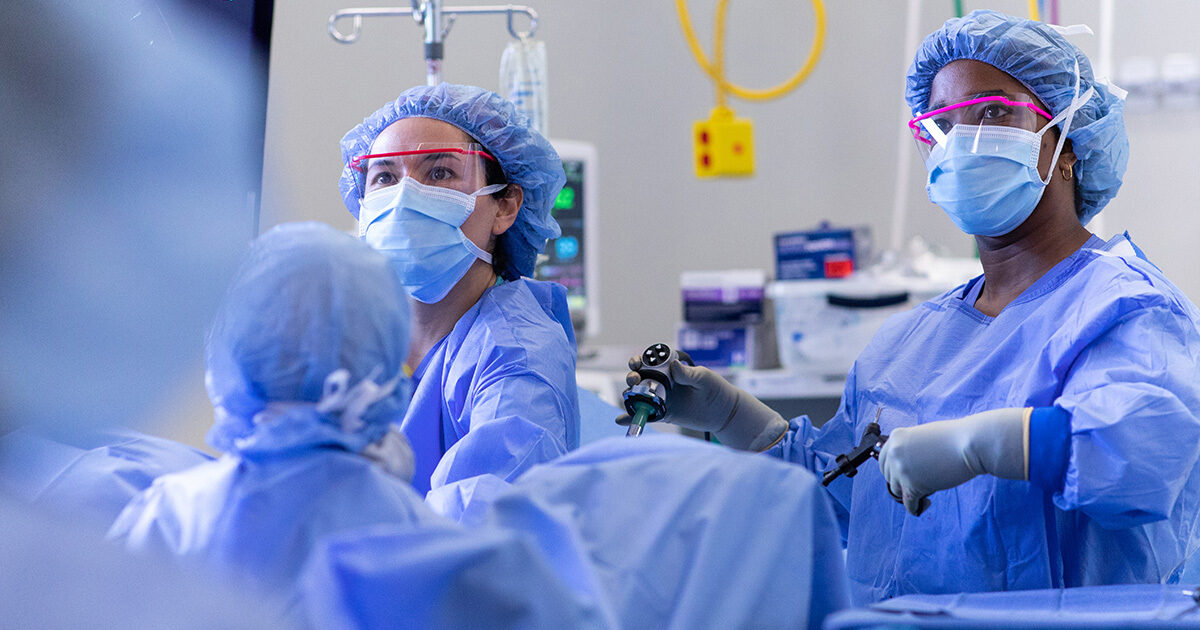What Sets Minimally Invasive Gynecologic Surgery Apart?
A UT Health Austin fellowship-trained gynecologic surgeon shares the advantages of minimally invasive gynecologic surgery
Reviewed by: Jenny Travieso, MD, FACOG
Written by: Lauren Schneider

Minimally invasive gynecologic surgery is the use of less invasive techniques, such as robotic, laparoscopic, hysteroscopic, or vaginal surgery, to treat a range of both common and complex gynecologic conditions. Minimally invasive techniques require only a few small incisions, with some procedures requiring no incisions at all. Some procedures can be performed on an outpatient basis in which patients are able to return home the same day, while others may require a short one- to two-night hospital stay.
“The goal of minimally invasive gynecologic surgery is to give people the safest surgery with the quickest recovery,” explains UT Health Austin fellowship-trained minimally invasive gynecologic surgeon Jenny Travieso, MD, FACOG, in Women’s Health, a clinical partnership between UT Health Austin and Ascension Seton. In traditional open surgery, a large incision is made so that the surgeon has a full view of the structures and organs involved. Minimally invasive procedures reduce the need for such a large incision through alternative methods of viewing or reaching the relevant structures and organs.
Education and Training
In addition to the four years of medical school and four years of residency training required to practice obstetrics and gynecology, minimally invasive gynecologic surgeons are required to complete a two-year fellowship program overseen by the American Association of Gynecologic Laparoscopy (AAGL). “During the fellowship, we operate three to five days a week for two years straight and come out of the fellowship having performed hundreds of surgeries,” says Dr. Travieso, adding that members of the Minimally Invasive Gynecologic Surgery care team at Women’s Health continue to perform a high volume of surgeries well into their career. “Our surgeons operate at least once a week.”
For some patients, this experience level makes all the difference. “While minimally invasive gynecologic surgeons treat many of the same conditions as other gynecologic surgeons, patients should consider our team not for which conditions we treat but for how we approach their care,” explains Dr. Travieso. “For instance, patients with noncancerous growths called fibroids that are very large or require myomectomy, a fertility-sparing surgery, are more likely to undergo a minimally invasive procedure with an experienced surgeon. Patients with endometriosis would also benefit from a surgeon with expertise in minimally invasive surgery to allow for complete excision of the implanted tissue while reducing pain and sparing organs, such as the ovaries. At our practice, we can evaluate endometriosis patients for other sources of pelvic pain and track their condition over time.”
Conditions treated by the Minimally Invasive Gynecologic Surgery care team include:
- Abnormal Uterine Bleeding
- Adenomyosis
- Asherman’s Syndrome (Intrauterine Adhesions)
- Chronic Pelvic Pain
- Endometriosis
- Infertility Pathology
- Ovarian Cysts
- Painful Intercourse/Dyspareunia
- Painful or Irregular Periods
- Pelvic Adhesive Disease
- Postmenopausal Bleeding
- Tubal Disease
- Uterine Fibroids
Benefits of Minimally Invasive Gynecologic Surgery
“While the benefits of each procedure may vary, minimally invasive gynecologic surgeries are associated with a decreased risk of infection or other complications, less pain and blood loss, and a shorter recovery time, meaning patients have shorter hospital stays and can return to their regular routine sooner,” explains Dr. Travieso. The patient experience varies by procedure, and patients receive the most relevant information during pre-surgical counseling with the Minimally Invasive Gynecologic Surgery care team. Most surgeries are outpatient (“same-day”) procedures performed at UT Health Austin’s Ambulatory Surgery Center, Seton Medical Center Austin, or Dell Seton Medical Center. After surgery, follow-up appointments are scheduled to monitor patient progress.
Types of Minimally Invasive Gynecologic Surgery include:
- Laparoscopic surgery: a type of surgical procedure that allows a surgeon to access the inside of the abdomen and pelvis without having to make large incision in the skin. Laparoscopic surgery is proven to result in shorter hospital stays, less discomfort, and a shorter recovery period.
- Hysteroscopy: A procedure that allows a surgeon to examine the inside of the cervix and uterus using a thin, lighted tool called a hysteroscope that is inserted in the vagina. Hysteroscopies do not require any incisions and have minimal recovery time.
- Robotic surgery: A type of surgery during which a surgeon uses a computer to control small surgical tools attached to a robotic arm. Robotic surgery has the same advantages as advanced laparoscopic surgery and allows surgeons to operate with increased precision and accuracy while minimizing trauma to surrounding tissues. Also known as robotic-assisted surgery.
- Vaginal surgery: Surgery that is performed through the vagina, the most minimally invasive approach to major gynecologic surgery. Vaginal surgery has all of the recovery advantages associated with laparoscopic and robotic surgery while also avoiding any abdominal incisions; however, there are visual limitations with this surgical approach.
“Individuals undergoing gynecologic surgery should explore their options to find a provider who best suits their needs,” says Dr. Travieso. “At Women’s Health, we use the latest technology to deliver specialized procedures and offer personalized treatment options with a focus on increasing the patient’s overall quality of life.”
To learn more about the Minimally Invasive Gynecologic Surgery service offered through Women’s Health, click here.